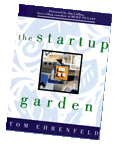Deviance or just good ole salemanship?
The new book The Deviantís Advantage: How Fringe Ideas Create Mass Markets raises a few questions. How new are "new" business ideas? How important is branding when it comes down to intellectual capital? Does cool count as a source of competitive advantage?
Deviants, by consultant/futurists Ryan Mathews and Watts Wacker (could someone named Watts Wacker be anything but a futurist?,) claims to be "the first book to tackle the issue of innovation truly begins and what happens to it after the innovation has fallen from popular fashion." To quote Public Enemy, donít believe the hype.
This new book is well executed, butÖnot very innovative. While the authors would like you to believe that this is a radical new book about how radical new ideas become accepted by the business mainstream, their ideas are hardly new. You can trace the trajectory of their model (in which big new ideas move from the Fringe to Social Convention) in a long line of books. Everyone from Malcolm Gladwell (The Tipping Point) to Everett Rogers (Diffusion of Innovations), which itself borrows from earlier studies) to Geoffrey A. Moore (whose excellent books include Crossing the Chasm and Inside the Tornado) to Emanuel Rosen (The Anatomy of Buzz) has already tackled this topic.
Yet the authors, tapping the lexicon of cool to sell their ideas, would like you to believe that they are fringe thinkers introducing a new idea about social or technological adoption. I was happy to see that they grudgingly tip their hat to a far superior book on the topic of corporate deviance: The Age of Heretics by Art Kleiner. Kleinerís gracefully written, hype-free social history of rebels within corporate life, provides rich color and insights into how radical ideas kick and scream their way into the fundamentally conservative life of corporations.
Itís hard not to take these guys with a huge grain of salt. Just as they are touting Bugsy Siegal as a classic deviant, they claim that Las Vegasís evolution from desert outpost of sin to an adultís Disneyland represents a classic arc of deviance acceptance. Arguably true, but ultimately not a very radical idea, and not that significant. Whatís new? We know that commercialism, in its lumbering and inexorable spread, relentlessly assimilates all that was once radical and counter-revolutionary into its faux-chic marketing brigade. Combine that with the free-market, free-speech, free-mania zeitgeist of our MTV-addled culture, and itís little surprise that so-called deviancy now sells soap and luxury cars.
This book is smart and well-written, but thereís something about these guys that just rubs me the wrong way. "The Deviantís Advantage" is ultimately a conventional book about radical thinking. The authors would like you to believe that their core message is fizzier than it actually is. In other words, their packaging proves the argument more by pitch (and tone) more than the substance. Itís "pitch" perfect, but doesnít ring true.
This book uses the allure of cool to sell itself. The authors cool-drop throughout the book, with references to overdone hip emblems like Burning Man (trust me, you really donít need to know about this ridiculous overhyped desert potlatch) and Hush Puppies. If youíve been reading Wired Magazine, or even Us Weekly, youíll get most of the references.
They strive to create a new vocabulary, coining the annoying word "devox" to connote the voice and spirit of deviant ideas. (Actually, they call "devox" a neologism rather than a word. Beware people who call words neologisms.) They build a model of devox, which one must assume is at the heart of their consulting practice. Naturally they have a consulting service and website.
Hereís where I take issue. "Cool" sells consultants and books. But cool is not what runs corporations. Like happy families, big businesses are often the same at heart. Well-run large companies share many similar practices, and many of these disciplines are inherently conservative, and thereís nothing wrong with that. Iím more interested in how well companies deliver on their mission and values than on how effectively they manipulate social trends into cynical products.
One of the timeless verities the authors implicitly recognize is the enduring power of corporate budgets for futurists. Hence they pitch their ideas to folks in need of cool, dressing up their patented ideas for big business brand managers who donít want to miss out on claiming to capture the glamour of the soi-disant New Economy.
Ultimately this book leaves the reader with a cheap, sad feeling. For the authors fold in all that might be authentic or "deviant" in their message into a much less interesting sales pitch forÖtheir pitch. They assimilate anything potentially interesting or authentic into a far less interesting product. Selling, not thinking, is the raison díetre of this book. And they embody this by taking all those cultural references that might have deeper resonance and packaging them into a bland "devox" model that wannabe-chic marketers can quote to impress folks at meetings. This book has the veneer of hip, and one suspects that the authors are happy to skateboard their faux-cool-cred all the way to the bank. Donít buy it.
Posted by tom at September 24, 2002 10:13 AM

